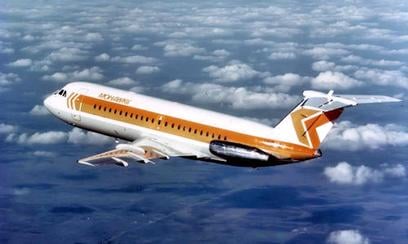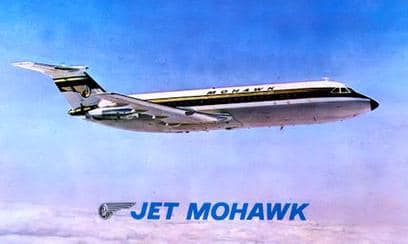Mohawk Airlines certainly boasts a tumultuous past littered with crashes, fatalities, and even a hijacking. However, on the positive side, it was also known as the first U.S. airline to hire an African-American flight attendant.
But many readers not familiar with the Mid-Atlantic, regional commercial airline might know it less for its history operating for a few decades from the 1940s until the early 1970s, and more for its appearance on the show Mad Men, as a client of fictional ad agency Sterling Cooper.
So what’s the Mohawk Airlines’ true story?
Mohawk Airlines Ascent to Popularity
Mohawk Airlines didn’t actually become Mohawk Airlines until the 1950s, the name chosen because of the many routes the airline offered in the Mohawk Valley of New York State. Before that, the airline was Robinson Aviation, founded in the 1940s and operating on a very small scale. It was after the purchase of several aircraft (some “modern” Douglas DC-3s to complement the tiny Beechcraft Model 18 aircraft), some rebranding, and some leadership restructuring that Mohawk Airlines grew to carrying 2 million passengers in 1953, serving 15 airports and generating $24.3 million in revenue.
Mohawk Airlines: The Airline Of Many Firsts
All this time, Mohawk Airlines operated out of Ithaca, New York, before moving to Utica and introducing Convair 240 aircraft to its fleet in the mid-1950s, around the same time it historically hired the nation’s first African-American flight attendant, Ruth Carol Taylor. Unfortunately for Taylor, the airline was not open-minded enough at that time to allow married attendants to serve its passengers, and so Taylor was dismissed shortly after her hiring for her marriage.

However, this was far from the only “first” that Mohawk Airlines was accomplishing during this time period. Mohawk Airlines was the first airline to introduce pressurized aircraft to local routes in New York State. It was the first airline to use centralized, computer-based reservations services. It was the first regional airline to use flight simulators and to fly jets, with the addition of the BAC 1-11 aircraft to its fleet.
These years of the late 1950s and the early 1960s were Mohawk Airlines’ heyday — it just didn’t know it yet. The airline’s fleet grew to include Convair 440 aircraft, the Martin 4-0-4 and the Fairchild Hiller FH-227. In total, Mohawk Airlines would serve nearly 50 different airports over its lifetime, including several international destinations (Toronto and Montreal). It would operate more than 75 aircraft over its lifetime as well.
In the late 1960s, though, the accidents started.
Descent into History, Not The Good Kind
Mohawk Airlines experienced its first accident in 1963, though it would not be its deadliest, not at all. A Martin 4-0-4 aircraft attempted to take off in Rochester, during inclement weather. The aircraft flipped after its wingtip hit the ground and seven people were killed.
In 1967, a BAC 1-11 aircraft on its way to Washington, D.C., caught fire in the rear and all 34 people were killed when the aircraft crashed into a rural town in Pennsylvania.
Just two years later, 14 people died when a Fairchild-Hiller FH-227B aircraft crashed off the shore of Lake George in New York, as it attempted to land.
In 1972, an aircraft of the same make crashed into a house in Albany as it tried to land at the local airport. Seventeen people died, including one person at the home.
Most notably, though, Mohawk Airlines experienced a hijacking in 1972, when a flight from Albany to LaGuardia was diverted to Westchester, also in New York. The hijacker did not hurt any of the passengers, but asked for $200,000 in cash while holding the crew hostage. The hijacker received the money and then demanded the crew fly the plane to another airport in New York State, where he tired to drive away once landed, but was killed by the FBI.

Crashes, Hijacking Didn’t Stop Growth
Meanwhile, in 1962, even though Mohawk Airlines had grown considerably, it hadn’t raised its profits past what they were in 1953. In 1971, Mohawk Airlines finally couldn’t pay its bills any longer.
In 1972, Mohawk was merged with Allegheny Airlines, which was headquartered in Pittsburgh and operated many similar routes. Of course, Allegheny Airlines would later become known as US Airways, which American Airlines purchased with much media coverage in 2015.

Great reading about some of the old operations. I flew freight in the 1990’s in a Convair 440 that still had the faint markings of Mohawk. Later I worked for American, which was then purchased by US Air. US Air is using the AA branding.
Thank you. Looking forward to hearing about others.
My Dad, Jim Johnson, flew that plane (18 Juliet) and probably every other one in the Mohawk fleet from the very early 1950’s till the merger with Allegheny, and onward to 1975 when he had a medical and had to retire.
Flying on a Mohawk BAC 1-11 in the early 70’s with the pending take over by Allegheny the pilot did a wing waggle. I thought “what the hell”, then I saw another 1-11 heading the opposite direction and at the same altitude doing a wing waggle, OK I thought, these guys are both short timers. When we arrived in Cincinnati (CVG) we flew directly over the airport and I expected the pilot to continue for a few miles before starting his approach, but to my surprise he proceeded to do a “combat” approach and dove in a tight descending spiral for the runway and made a beautiful flare for a nice touch down. “Definitely a short timer” I thought.